Description
Avocado, Persea americana, is an evergreen tree in the family Lauraceae which grown for its nutritious fruit, the avocado. The avocado tree is large and dome shaped with oval or elliptical leaves arranged in a spiral on the tips of branches. The leaves have a red pigmentation when they first emerge and turn green as they mature. Avocado trees produce clusters of small, green-yellow flowers at the end of twigs and a large, fleshy, pear-shaped fruit with a single large seed. The fruits can be purple to green in color with smooth or warty skin depending on variety. The flesh of the fruit is yellow-green in color and has the consistency of butter. Each fruit contains one large seed. Avocado trees grown from seed can take 4–6 years to produce fruit whereas grafted plants may produce fruit within 1–2 years. The tree can reach a height of 20 m (65.6 ft) and originated in the rainforests of Central America.
Crop Details
Scientific Name: Persea americana
Common Name: avocado, alligator pear (En); aguacate, palta (Sp); parachichi (Sw)

Harvested avocados

Fruit developing

Fruit on the tree

Avocado seed

Close up of avocado flowers

Avocado blossoming

Avocado foliage

Avocado fruits

Avocado tree
Uses & Benefits
The avocado is usually consumed fresh as a fruit or as an ingredient in salads or savory dishes. It has a markedly higher fat content than other fruits and is a staple in diets that have limited access to foods with high contents of monounsaturated fats. It is the main ingredient in guacamole, a popular Mexican dip. In Asia, avocados are used in desserts and dessert drinks.
Avocados are a source of vitamins C, E, K, and B6, as well as magnesium and potassium.
Varieties of Avocado
There are three horticultural races in which all avocado varieties are classified: Guatemalan, West Indian, and Mexican. However, many commercially interesting varieties are hybrids.
Some examples of Mexican race varieties are Zutano, Fuerte, Puebla, and Teague, while some examples of Guatemalan race varieties are Hass and Reed, among others. West Indian race varieties include Waldin, Hardy, and Simmonds.
Propagation
Basic Requirements
Avocados thrive in subtropical or tropical climates but can also be grown successfully in cooler areas of the world. The optimum temperature for growing avocado is between 25 and 33°C (77–91.4°F) with moderate humidity levels. Once established, trees can tolerate temperatures down to around -2°C (28°F) with minimal damage but young trees will not tolerate freezing temperatures. Avocado requires a well draining, aerated soil and they produce a shallow root system which require a warm soil for efficient water and nutrient uptake. Although trees will tolerate low rainfall, irrigation, particularly during flowering and fruit set, will ensure high fruit yields.
Seeding
Avocados are commonly propagated from seeds but the seeds will not breed true due to type and this should be taken into consideration before planting. Clonal plants are obtained from budding and grafting from a parent tree to ensure the offspring are of the same high quality of the parent. In plantations, seeds can be sown directly in the soil. 2 to 3 seeds are usually sown and thinned later to leave the strongest seedling for grafting. Seeds may also be sown in containers and grown for 2 to 3 months before planting at the final site.
Avocado seedling should ideally be planted in the Spring when the soil has warmed through. Choose a location that receives full sun and has protection from the wind. The trees should be planted by digging a hole a little wider than the root ball and gently easing the tree into the hole. Slow release fertilizer can be added to the hole at planting but is not necessary. Care should be taken not to disturb the roots as much as possible and the hole should be carefully backfilled and the soil and tamped to prevent dislodging. Trees should be planted 4.5 to 6 m (15–20 ft) apart in rows spaced 6 m (20 ft) apart.
General Care and Maintenance
Newly planted young trees should be mulched after planting with several inches of straw or woodchips. Young trees will also benefit from staking which will help to prevent wind damage. Wood stakes should be driven into the ground outside the root ball allowing 2 stakes per tree. The tree should then be tied loosely to the stakes to provide support while it establishes.
Young trees should be irrigated and the root ball should not be allowed to dry out. Trees should be watered every few days. Water trees at and around the base to ensure the root ball is wetted. Trees are usually fertilized at around 4 weeks after planting. Add half a cup of urea every 4 to 6 weeks during the growing season. One avocado tree can yield 250-300 kg of fruit per harvest season. This causes a high demand on soil nutrients. To determine the right amount of manure to apply, the soil should be tested annually.
Initial pruning may be done to give the tree a good shape. Otherwise pruning is limited to the removal of dead wood and parasitic plants. Remove all sucker and dead branches from main trunk branches. Prune canopy to keep the tree to a height of 5-8 m and for ease of picking. The tree is very susceptible to sunburn, therefore pruning should be minimised. Prune the larger tree roots by cultivating to a depth of 50 cm around the edge of the tree canopy.The area around the tree should be kept clean by weeding and removal of all fallen fruits.
Harvest
Harvesting starts at 3-4 years from planting but a good yield is obtained from the 6th year onwards. It is not easy to tell when the fruits are ready for harvesting unless they are of the varieties that change colour at maturity. Harvest a sample and keep at room temperature. If they soften within 7-10 days without shrivelling then the fruit of that age are ready for harvesting.
Common Pests and Diseases
Diseases
Category : Viral
Algal leaf spot
Cephaleuros virescens

Algal leaf spot symptoms

Algal leaf spot symptoms

Algal leaf spot symptoms

Algal leaf spot symptoms

Close up of algal leaf spot lesion

Algal leaf spot symptoms
Symptoms
Raised, orange-red spots on both upper and lower surfaces of leaves; spots may coalesce to form irregularly shaped patches; spots may also be present on twigs and branches; when the surface of the spot is scraped away, a gray to dark necrotic crust is visible
Cause
Alga
Comments
Management
Ensure that trees are properly pruned and fertilized to promote vigor; remove all weeds from around tree bases; employ a wider tree spacing to increase air circulation around the trees; badly infested trees can be treated with copper containing fungicides
Sunblotch
Avocado sunblotch viroid (ASBVd)
Symptoms
Red, yellow, pink or white streaks running the length of young stems; white, yellow or red blotches on fruit
Cause
Viroid
Comments
Management
Frequently sanitize all pruning equipment with disinfectant; plant only certified nursery stock
Category : Fungal
Anthracnose
Glomerella cingulata

Anthracnose symptoms

Anthracnose symptoms

Anthracnose symptoms

Anthracnose symptoms

Anthracnose symptoms
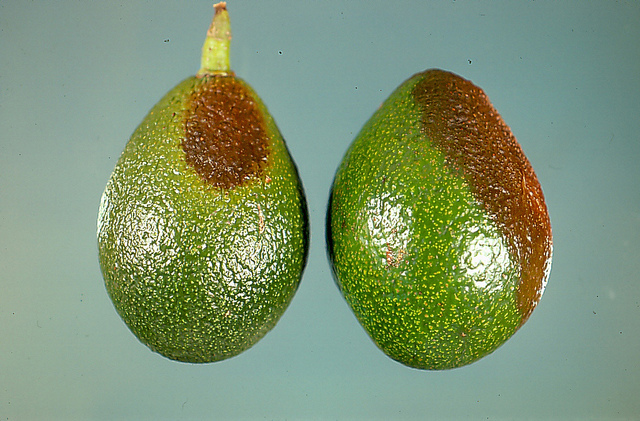
Anthracnose symptoms

Anthracnose symptoms
Symptoms
Chlorotic and necrotic spots; dead leaf tip; defoliation; brown or purple lesions on new shoots
Cause
Fungus
Comments
Management
Prune dead twigs and branches from tree before fungi produce spores; knock dead leaves out of canopy; keep harvested fruit dry and cool
Black streak
Avocado black streak
Symptoms
Elongated black streaks on bark; cankers parallel to growth of limbs; black blotches with distinct margins on green wood; cankers on bark cause cracks which ooze sap; removal of bark over cankers reveals dark discoloration underneath
Cause
Unknown
Comments
Management
Avoid stressing trees by following good fertilization and irrigation practices
Scab
Sphaceloma perseae

Avocado scab symptoms

Scab symptoms

Avocado scab
Symptoms
Oval or irregular brown or purple spots on fruit with rough texture.
Cause
Fungus
Comments
Management
Plant tolerant varieties; spray with copper containing fungicides.
Stem-end rot
Many different fungal species. Depends on growing region. Mainly Botryosphaeria dothidea in the US.
Symptoms
Shrivelled tissue at stem end; dark brown or black lesions at stem end and eventually over entire fruit; fruit covered in mycelium
Cause
Fungi
Comments
Management
Prune dead limbs and twigs; prune and harvest in dry conditions; provide trees with sufficient irrigation; apply a thick layer of mulch
Category : Bacterial
Bacterial soft rot
Erwinia herbicola
Erwinia carotovora
Symptoms
Gray to black, mushy, foul smelling rot on fruit; fruti has darkened metallic sheen
Cause
Bacteria
Comments
Management
No treatment for disease; use certified seed; disinfected tools and cuttings; employ crop rotation; remove plant debris from soil
Category : Oomycete
Phytophthora root rot
Phytophthora cinnamomi
Symptoms
Black lesions on roots; black, brittle roots; small, yellow leaves; premature leaf drop; decline in fruit yield
Cause
Oomycete
Comments
Management
Minimize water splash between trees by not working in a wet orchard; prune out dead limbs and twigs; remove fruit from the ground; dispose of dead wood and fruit away from trees
Pests
Category : Insects
Avocado thrips
Scirtothrips perseae

Avocado thrips
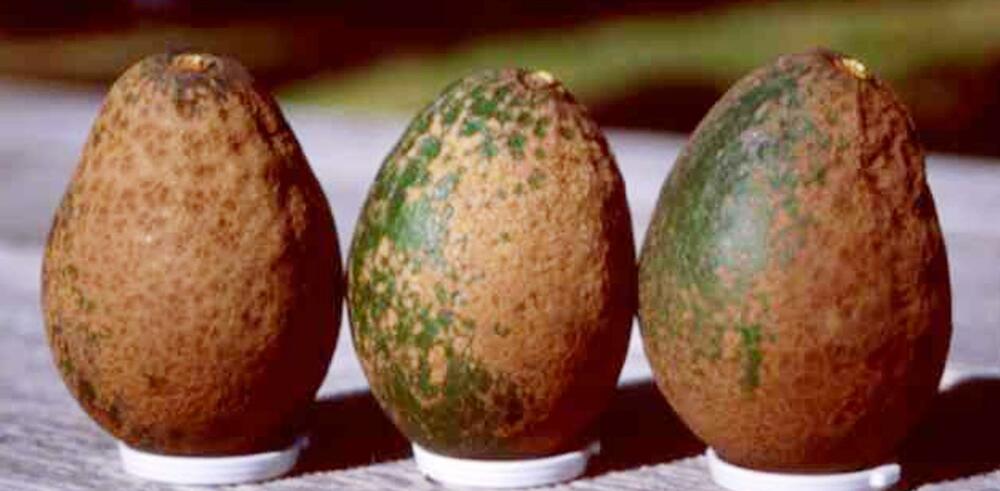
Scarred avocado fruits
Symptoms
Obvious feeding scars on fruit; scars begin as scabs or leathery patches and spread across fruit; adult insect is orange-yellow in color with distinct brown bands and reaches 0.7 mm (0.03 in) in length
Cause
Insect
Comments
Management
Addition of coarse organic mulch about 6 inches thick below trees may help to reduce survival of thrips pupating in soil; if insecticides are to be applied, a selective insecticide should be selected to reduce damage to populations of natural enemies; Sprays of Entrust are organically acceptable
Western avocado leafroller (Amorbia)
Amorbia cuneana

western avocado leafroller (Amorbia cuneana) larvae
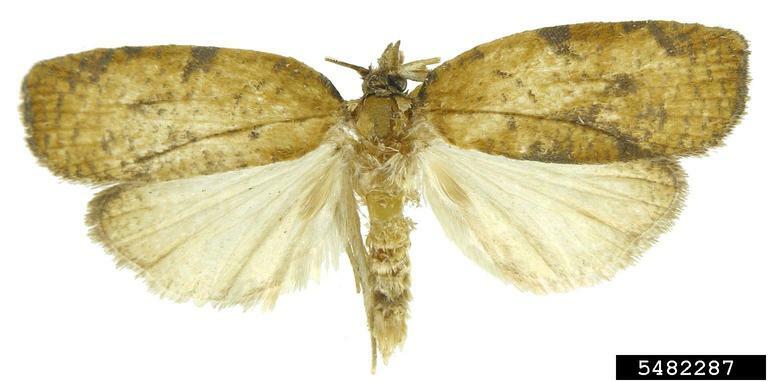
Adult western avocado leafroller (Amorbia cuneana)
Symptoms
Upper surface of leaves consumed, leaving thin brown membrane or leaves skeletonized; defoliation of tree; terminal leaves joined together by silk webbing; scarred fruit; young larvae are yellow-green and mature to dark green and a short, dark horizontal line on the side of their thorax; adult is a orange or tan moth with dark markings and bell-shaped wings.
Cause
Insect
Comments
Management
Healthy avocado trees can tolerate feeding damage well but insect may become problematic if defoliation causes sunburn on fruit; applications of selective insecticides such as Bacillus thurengiensis help to conserve populations of natural enemies; pruning trees so that terminal foliage does not touch helps to prevent leafroller movement between trees.
Category : Mites
Persea mites
Oligonychus perseae

Persea mites (Oligonychus perseae) damage to avocado leaf

Damage to avocado leaf due to mite

Mite damage on leaf underside
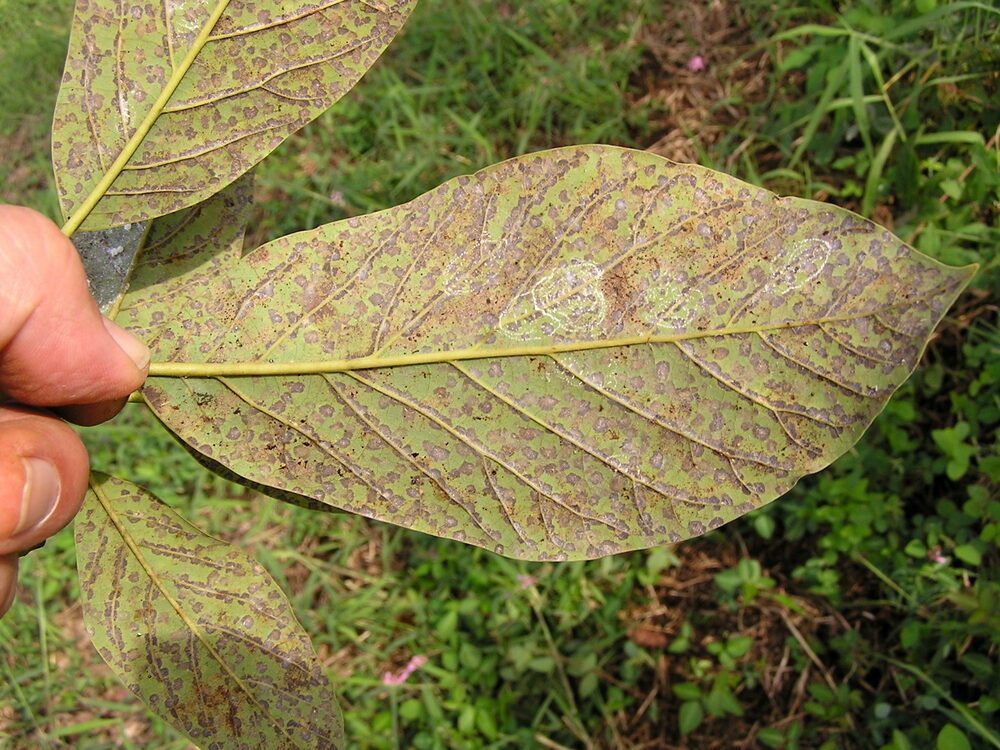
Mite damage

Persea mite (Oligonychus perseae) injury
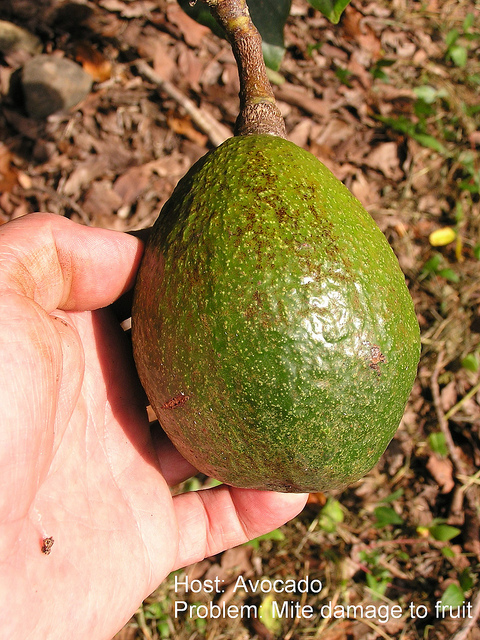
Mite damage on avocado fruit

Persea mite damage

Persea mites (Oligonychus perseae) damage to avocado (Persea americana) leaves

Symptoms of mite feeding on avocado leaf
Symptoms
Tree dropping leaves and becoming defoliated causing sunburn damage to exposed bark and fruit; mites cause the development of circular chlorotic to brown spots on the undersides of the leaves and fruit surface; dense colonies of mites produce silk webbing which may appear as a silvery spot; large mite populations can cause the entire tree canopy to appear lighter in color.
Cause
Arachnid
Comments
Management
Ensure the tree is adequately fertilized, pruned properly and irrigated to avoid unnecessary stress to the tree which can make them more susceptible to mite attack; persistent infestations may require treatment with an appropriate chemical; organic controls include several types of horticultural oil.






































